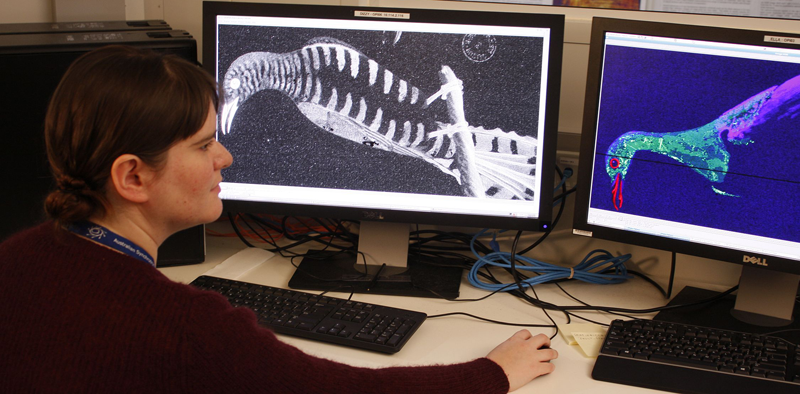17 June 2014
Early drawings reveal their secrets under x-ray examination

Some of Australia’s earliest scientific drawings are finally giving up their secrets under the watchful eyes of Australian Synchrotron scientists and conservators from the State Library of New South Wales (SLNSW).
The exquisitely-detailed drawings of birds and flowers date from 1791 to 1792, in the early days of European settlement in NSW. Cultural materials conservators Kate Hughes and David Thurrowgood from SLNSW brought five of the drawings to the Synchrotron in June 2014 to determine the composition of the gold leaf, finely ground mineral pigments and other materials used to create the drawings.
The drawings are from SLNSW’s TAL & Dai-ichi Life Derby Collection, which comprises 741 artworks depicting local plants, birds and fish, compiled in the 1790s by leading naturalist and botanist Aylmer Bourke Lambert. In 1842, the entire collection was purchased by the 13th Earl of Derby, a legendary natural history collector.
A key feature of the drawings brought to the Synchrotron is their use of gold, silver and brass leaf with watercolours to create iridescent effects. The drawings cannot be touched due to their delicate nature, so the Synchrotron is the only way to examine the very fine detail of the drawings, in which many of the brushstrokes are finer than 0.1 millimetre.
Synchrotron information about the chemical composition of the artists’ materials will be used to verify the provenance of the drawings, which are believed to be originals done in Australia rather than copies done in another country such as India. Knowing more about the composition of the materials could also help identify the artists.
The researchers will develop a pigment composition database and use their synchrotron findings to validate a method for assessing other works in the SLNSW collection using laboratory based technologies. The information will be shared with colleagues at the Natural History Museum in London.
The experiment will add accurate data to the unfolding story of the First Fleet and how people were making artwork in the colony. This is a whole new area of research being led by the State Library, which holds an unrivalled First Fleet collection.
The analysis was carried out on the Synchrotron’s x-ray fluorescence microscopy (XFM) beamline with Daryl Howard. This non-destructive synchrotron technique can map which elements (such as gold, copper, zinc and iron) are present in a sample, along with their locations and chemical form. XFM can resolve details as small as 0.1 micrometres across (less than one-thousandth the diameter of a typical human hair) and detect much lower concentrations of elements than laboratory-based techniques. It also collects data on timescales that make it possible to scan entire works of art.
Other historical and cultural materials examined on the XFM beamline include Aboriginal ochres, paintings from NGV, and the de Vlamingh plate from WA (one of Australia’s oldest records of European contact).
XFM is more commonly used for research and development work to help the mining industry improve its productivity and environmental performance, and by biomedical researchers. Recent uses include examining the role of metals and metal-containing enzymes in diseases such as Alzheimer’s, and investigating how the body deals with zinc oxide nanoparticles in sunscreens. It is increasingly important for agricultural researchers, with applications that include assisting the development of rice and other grains with improved levels of essential minerals, and the development of more-effective phosphorus fertilisers.
More highlights from the XFM beamline
Article in The Age 17 June 2014
State Library of NSW TAL & Dai-ichi Life Derby Collection










